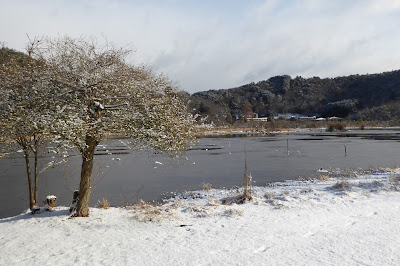It is odd
to imagine that once upon a time this stately piece lay buried in a peat bog on
the outskirts of Kyoto city. The handsome fella is in fact a bodhisattva Jizo
statue, and the bog none other than our Midoroga pond. This Jizo is believed to
be one of six similar statues carved from a single tree by one Ono-no-Takamura,
a scholar who lived, died, then lived again in the early Heian period. The
legend tells how the man passed, spent time in the underworld, then rose from
the dead after some serious worshipping the Jizo. Once back on earth Takamura set
about carving the six statues in the heat of religious verve.
* Creatures surviving since the Ice Age
* Biological communities designated as natural treasures
* A pond of many legends
* The name’s origin unknown. One link to the discovery of "Miroku Bosatsu Bodhisattva statue" inside the pond
* Midorogaike 深泥池: a straight reading of kanji impossible, loosely translated as ‘a bottomless muddy pond’
The
finished products were individually distributed to guard each one of the six
ancient routes linking Kyoto with various towns and municipalities, such as
Fushimi, Toba, Nagoya etc. Kurama-kaido
connected Rakuchu (inner Kyoto city) to Shiga and beyond. It had the statue –
affectionately known by locals as Kuramaguchi, or Midorogaike, or Aneko Jizo – posted
at the road’s entrance, serving as a safe journey guardian.
Kurama-kaido used to pass by Midoroga pond. Tradition
has it that nearby lay ‘a demon gateway’. The demons were supposed to reside in
Kurama and Kifune, a few kilometres north of the pond. In order to keep the
wretches at bay, the custom of bean-throwing (mamemaki, 豆まき) sat about at a nearby Yoshida
shrine and has been continued to this day as part of the Setsubun (節分) celebrations at the start of
spring (Feb 3rd).
It
remains unclear though how this particular statue ended up in the bog, or the
way it was found and retrieved from its muddy cradle. Currently the statue, all
spruced up, sits enshrined at Jozenji near the present day Kuramaguchi subway
station – once a boundary separating the inner city (rakuchu) from the suburbs
(rakugai), or ‘the world beyond’.
Jozenji
is one of those local ‘B-temples’, exuding a certain dose of neglect and lack
of refinement (an odd carton box in the worship hall, a motorbike casually
stationed by the main entrance). At the same time this semi-lax atmosphere
lends it an air of intimacy that is largely absent from its more famous,
touristy cousins. In late August pilgrims flock to the temple for the Kyoto
Rokujizo Meguri – a pilgrimage to Six Jizo temples. The ceremony involves the worshippers
walking along the route connecting the points of the ancient roads, as well as hanging
paper amulets (ofuda) outside their
homes for exorcising unquiet spirits. The powers of superstition drag on.
Midorogaike
* A pond about 1,500m in
circumference* Creatures surviving since the Ice Age
* Biological communities designated as natural treasures
* A pond of many legends
* The name’s origin unknown. One link to the discovery of "Miroku Bosatsu Bodhisattva statue" inside the pond
* Midorogaike 深泥池: a straight reading of kanji impossible, loosely translated as ‘a bottomless muddy pond’


No comments:
Post a Comment